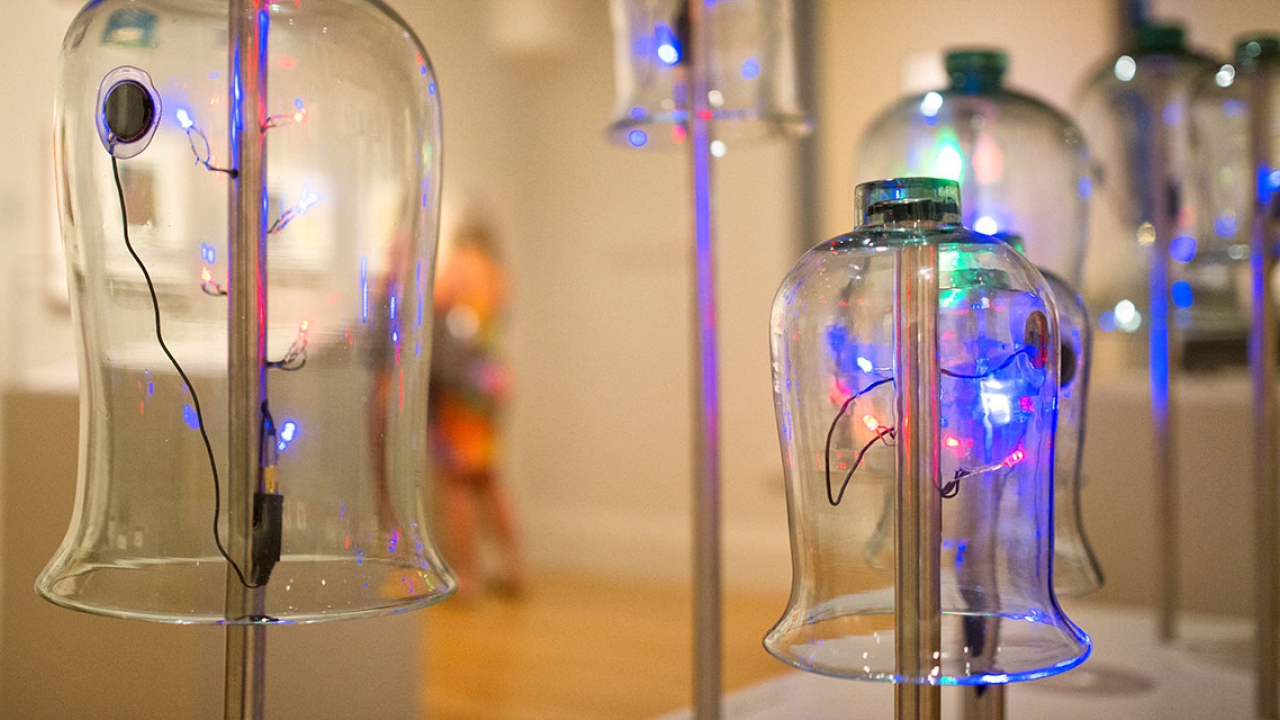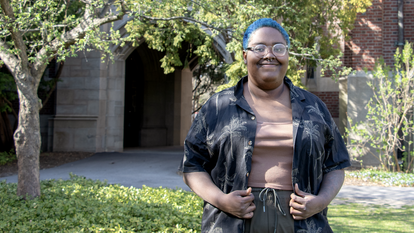Museum Installation by Wellesley Music Professor Evokes the Legacy of Writer Sylvia Plath

More than 50 years after her death, the work of Sylvia Plath (1932–63) continues to challenge and inspire readers with its bold, imaginative imagery. A new exhibition at the National Portrait Gallery in Washington, D.C., One Life: Sylvia Plath, illustrates the many ways Plath has influenced other writers as well as musicians, dancers, and visual artists.
An interactive installation in the exhibit created by Wellesley’s Jenny Olivia Johnson, associate professor of music, allows museum visitors to experience Plath’s legacy in an aural and tactile way. Glass Heart (Bells for Sylvia Plath), pictured above, is composed of eight bell jars that light up and emit haunting sounds when touched.
“I first came across the piece at the Davis Museum at Wellesley College in 2013 while I was on a research trip for this exhibition,” wrote exhibit curator Dorothy Moss on the gallery’s website. “I was struck by what I heard—a slow and expansive sound that filled or, rather, haunted the gallery. The sound, in combination with the work’s sculptural component—flickering firefly-like blue and red lights inside glass bell jars—was unlike anything I had ever experienced before in a museum.”
Johnson said the inspiration for Glass Heart came from these lines in Plath’s 1947 poem “I Thought I Could Not Be Hurt”:
How frail the human heart must be —
a mirrored pool of thought. So deep
and tremulous an instrument
of glass that it can either sing,
or weep.
“I find Sylvia Plath’s poetry to be highly sensory and evocative; her trenchant words often conjure intense visceral images and colors for me,” said Johnson, who describes herself as a “synaesthetic composer,” one who sees color in response to musical sounds. “I wanted to create a work of art that was as ebullient with admiration for and as shiveringly haunted by her poetry and prose as I am. I think music is a natural medium for conveying this kind of hauntedness.”
Johnson chose to work with bell jars, which are used to create a vacuum or to protect scientific equipment, for two reasons: They allowed her to create a set of glass “hearts” that would seem to sing or cry when tapped, and they echoed the title of Plath’s semi-autobiographical novel, The Bell Jar, in which the protagonist descends into mental illness.
When someone touches the display, red and blue lights mounted inside the jars flash—suggesting veins and arteries around a beating heart—and pre-recorded pieces of music emanate from them. “I was hopeful that visitors could have a variety of different kinds of experiences, and that they would be inspired enough by the mysteries of the piece to want to experience it multiple times: Why does this music happen when I touch it this way, and why does it change when I touch it that way? What does it mean when the lighting is slightly different?” Johnson said.
She also imagined Glass Heart creating a meditative space where visitors can sit and listen, periodically ringing the bell jars as they consider what Plath’s powerful words suggest to them individually.
Plath, who grew up in the town of Wellesley and graduated from Smith College in 1955, struggled with both mental illness and the challenges of establishing a literary career at a time when men dominated that field. “Plath and I had very different lives and came of age in almost unimaginably different eras,” Johnson said. “But I have always felt a kinship with the sheer intensity of her work. It is unrelenting, unapologetic, incendiary, confessional, and thorough. I have similar impulses in my own music and prose.”
As the academic year begins, Johnson hopes Wellesley students will consider Plath’s legacy as well. “Her work is uncompromising, multidisciplinary, and deeply intellectual. These qualities alone are ones that I think continue to inspire students in the present moment, especially the brilliant women who attend Wellesley,” she said.
Johnson also hopes that students who recognize themselves in Plath’s work will become aware of the cultural roadblocks she endured and of her quest for adequate support for her mental health challenges. “Both can offer immense insight,” she said.
The exhibition One Life: Sylvia Plath runs through May 2018.



